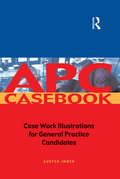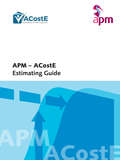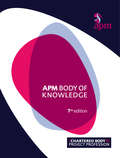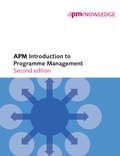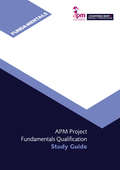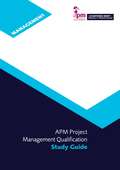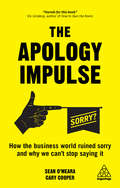- Table View
- List View
The Anywhere Leader: How to Lead and Succeed in Any Business Environment
by Mike ThompsonThe go-to resource for business leaders who must succeed no matter what the circumstances The world is rapidly changing and unpredictable, necessitating leaders who adjust quickly to changing priorities and unfamiliar terrain. This book offers a blueprint for developing leaders who can handle surprising challenges, from mergers to global relocation, and who thrive in turbulent times by being open to new concepts, passionate about progress, and resourceful with the tools available. Features three key traits of adaptable leaders: Driven by progress, Sensationally curious, Vastly resourceful Reveals how to work across corporate cultures and leverage relationships to overcome challenges Shows how to bypass the traditional leadership role and take necessary risks to move forward Written for the business leader who can land in any environment, under any set of conditions, and find a way to fit in and succeed.
The Anywhere Leader: How to Lead and Succeed in Any Business Environment
by Mike ThompsonThe go-to resource for business leaders who must succeed no matter what the circumstances The world is rapidly changing and unpredictable, necessitating leaders who adjust quickly to changing priorities and unfamiliar terrain. This book offers a blueprint for developing leaders who can handle surprising challenges, from mergers to global relocation, and who thrive in turbulent times by being open to new concepts, passionate about progress, and resourceful with the tools available. Features three key traits of adaptable leaders: Driven by progress, Sensationally curious, Vastly resourceful Reveals how to work across corporate cultures and leverage relationships to overcome challenges Shows how to bypass the traditional leadership role and take necessary risks to move forward Written for the business leader who can land in any environment, under any set of conditions, and find a way to fit in and succeed.
Anzeigenmarketing im Verlag: Eine empirische Analyse der Marketingressourcen und Marketingkompetenzen im Anzeigenmarketing von Zeitschriftenverlagen
by Richard PelzAuf der Grundlage eines ressourcentheoretischen Ansatzes identifiziert Richard Pelz verlagsspezifische Marketingressourcen und -kompetenzen als wesentliche Erfolgsfaktoren des Anzeigenmarketings.
Anzeigepflichten für Steuergestaltungen in Deutschland: Verfassungs- und europarechtliche Grenzen sowie Überlegungen zur Ausgestaltung (MPI Studies in Tax Law and Public Finance #7)
by Christine Osterloh-Konrad Caroline Heber Tobias BeuchertDas Buch befasst sich mit den verfassungs- und europarechtlichen Rahmenbedingungen einer Anzeigepflicht für Steuergestaltungen sowie mit ihrer möglichen Ausgestaltung in Deutschland, wobei auch auf Erfahrungen anderer Länder zurückgegriffen wird. Die Anzeigepflicht soll dazu dienen, Gesetzgeber und Verwaltung frühzeitig über Steuervermeidungsstrategien zu informieren, um ihnen eine zeitnahe Reaktion zu ermöglichen (rechtspolitische Zielsetzung). Ein Fokus der europarechtlichen Analyse liegt auf der Bewertung einer Anzeigepflicht für internationale Steuergestaltungen. Im Verfassungsrecht steht neben Bestimmtheits- und Rückwirkungsverbot die Berufsfreiheit der Betroffenen im Vordergrund. Die rechtspolitische Zielsetzung legt einen Zuschnitt der Anzeigepflicht auf modellhafte Gestaltungen nahe; eine Erweiterung auf innovative Gestaltungen erscheint denkbar. Das Buch schließt mit kritischen rechtspolitischen Überlegungen zur Anzeigepflicht im Rahmen eines fairen Steuersystems.
Apache Hive Essentials
by Dayong DuIf you are a data analyst, developer, or simply someone who wants to use Hive to explore and analyze data in Hadoop, this is the book for you. Whether you are new to big data or an expert, with this book, you will be able to master both the basic and the advanced features of Hive. Since Hive is an SQL-like language, some previous experience with the SQL language and databases is useful to have a better understanding of this book.
Apartheid, 1948-1994 (Oxford Histories)
by Saul DubowThis new study offers a fresh interpretation of apartheid South Africa. Emerging out of the author's long-standing interests in the history of racial segregation, and drawing on a great deal of new scholarship, archival collections, and personal memoirs, he situates apartheid in global as well as local contexts. The overall conception of Apartheid, 1948-1994 is to integrate studies of resistance with the analysis of power, paying attention to the importance of ideas, institutions, and culture. Saul Dubow refamiliarises and defamiliarise apartheid so as to approach South Africa's white supremacist past from unlikely perspectives. He asks not only why apartheid was defeated, but how it survived so long. He neither presumes the rise of apartheid nor its demise. This synoptic reinterpretation is designed to introduce students to apartheid and to generate new questions for experts in the field.
APC Case Book: Casework Illustrations for General Practice Candidates
by Austen ImberFollowing his succesful How to Pass the APC: Essential Advice for General Practice Surveyors, Austen Imber's latest publication examines surveyors' work in practice. The case work is based mainly on examples of APC candidates' critical analysis, and is supported by additional guidance on the key issues arising in practice. In a clear, practical way the book covers the public, private and corporate sectors and enables graduates to understand the roles of the various participants in the property industry.Subjects covered include investment valuation, development valuation/appraisal, profits valuation, the Red Book, lettings, sales, rent reviews, lease renewals, estate management, ratings, planning, development, regeneration, compulsory purchase, telecoms and insolvency. The hands-on style of the candidates' critical analysis, clearly shows the detailed reasoning behind the initial strategies and decisions throughout a case. The examples of APC interview questions and tasks for study are invaluable in encouraging graduates to consider further issues - including the many practical problems which graduates need to understand in order to succeed in practice and with their APC interview. Professional ethics are also represented within the cases featured.The APC Casebook is an essential tool in preparing for the final assessment stage of the APC, as well as being an important reference source for candidates throughout their APC training.
APC Case Book: Casework Illustrations for General Practice Candidates
by Austen ImberFollowing his succesful How to Pass the APC: Essential Advice for General Practice Surveyors, Austen Imber's latest publication examines surveyors' work in practice. The case work is based mainly on examples of APC candidates' critical analysis, and is supported by additional guidance on the key issues arising in practice. In a clear, practical way the book covers the public, private and corporate sectors and enables graduates to understand the roles of the various participants in the property industry.Subjects covered include investment valuation, development valuation/appraisal, profits valuation, the Red Book, lettings, sales, rent reviews, lease renewals, estate management, ratings, planning, development, regeneration, compulsory purchase, telecoms and insolvency. The hands-on style of the candidates' critical analysis, clearly shows the detailed reasoning behind the initial strategies and decisions throughout a case. The examples of APC interview questions and tasks for study are invaluable in encouraging graduates to consider further issues - including the many practical problems which graduates need to understand in order to succeed in practice and with their APC interview. Professional ethics are also represented within the cases featured.The APC Casebook is an essential tool in preparing for the final assessment stage of the APC, as well as being an important reference source for candidates throughout their APC training.
API Development: A Practical Guide for Business Implementation Success
by Sascha PreibischImplement application programming interface (API) usability, security, availability, reliability, and scalability to extend your company’s market and potentially generate revenue. Businesses know they need to extend their markets into the digital world, and expose internal data to the Internet. This book shows how stakeholders within an organization can make it a successful journey. Stakeholder needs are not identical and departments experience difficulties discussing requirements with each other due to their different fundamental understanding of the process. The goal of this book is to introduce a common language for all business groups—developers, security experts, architects, product managers—around APIs and provide an overview of all aspects that need to be considered when exposing internal data. Most of the content in this book is based on feedback from real-world enterprise customer questions, challenges, and business scenarios. Practical guidance is provided on the business value of APIs, the general requirements to know, and how to undertake an audience-based implementation. You will learn how to protect access to data, as well as API error handling, documentation, management, integration, and more. What You’ll Learn Know the types of APIs and their business and technical requirementsThe main benefits of APIs, including business value, loose coupling, and frequent updatesProtect access to APIs through role-based access, attribute-based access, and rate limitingDistinguish between OAuth and OpenID Connect, and know how they both workManage API error handling, including what should and should not be handledUnderstand the distinction between runtime, dynamic data, and static dataLeverage external APIs as part of your own APIs Who This Book Is For API developers, API security experts, software architects, product owners, and business owners
APL2-Handbuch (Informationstechnik und Datenverarbeitung)
by Hans LochnerDas APL2-Handbuch ist ein einführendes Nachschlagewerk für die Programmiersprache APL2, wie sie von IBM für PC/DOS, VM/CMS und MVS/TSO angeboten wird. Entsprechend wird auf eine vollständige Beschreibung der Sprache (Daten, Elementarfunktionen und -operatoren), der Editoren zur Definition eigener Funktionen und Operatoren, sowie der Systemfunktionen und -variablen Wert gelegt. Darüber hinaus wird eine Auswahl der wichtigsten Fehler- und Systemnachrichten sowie Systemanweisungen geboten, und zwar in ihrer deutschen Form. Das Buch wendet sich in erster Linie an Programmierer mit APL-Vorkenntnissen, insbesondere an APL2-Praktiker, die Antworten auf spezielle Fragen oder für bestimmte Grenzsituationen suchen. Dem entspricht die systematische Gliederung des Werkes mit seinen zahlreichen Tabellen. Für mathematisch interessierte Leser ohne APL-Kenntnisse oder für Leser mit Kenntnissen in anderen Programmiersprachen bietet das APL2-Handbuch auch eine Einführung in APL2. Für diesen Zweck wird eine APL2-Beispielsitzung kommentiert. Grundsätzlich gibt der Autor zu jedem Thema eine Einführung, der sich die eigentliche Darstellung anschließt, die jeweils mit vielen Beispielen versehen ist.
APM – ACostE Estimating Guide
by Association for Project Management Association of Cost EngineersEverything you need to know about estimating in one essential guide. Estimates are critical to project professionals; vital when making informed decisions about projects across the different stages of the entire project life cycle to ensure successful project delivery. A cooperation between the Association for Project Management (APM) and the Association of Cost Engineers (ACostE) this guide is vital for project professionals across various sectors, as well as anyone who needs to understand cost estimation. Created by collaborators with real-life experiences, Estimating Cost will help you understand and diligently apply the core values of estimating cost to improve the clarity and robustness of an estimate for better decision making. Key features include: * practical advice with a focus on cost estimating approaches, such as top-down, bottom-up, and ‘ethereal’; * guidance on the various estimating methods including analogy, parametric and trusted source; * applicability to the private sector and on a wide range of projects; * key figures, diagrams and frameworks you can build on and apply to your estimates.
APM Best Practices: Realizing Application Performance Management
by Michael J. Sydor Karen Sleeth Jon Toigo Ed Yourdon Scott E. Donaldson Stanley G. Siegel Gary DonaldsonThe objective of APM Best Practices: Realizing Application Performance Management is to establish reliable application performance management (APM) practices—to demonstrate value, to do it quickly, and to adapt to the client circumstances. It's important to balance long-term goals with short-term deliverables, but without compromising usefulness or correctness. The successful strategy is to establish a few reasonable goals, achieve them quickly, and then iterate over the same topics two more times, with each successive iteration expanding the skills and capabilities of the APM team. This strategy is referred to as “Good, Better, Best”. The application performance monitoring marketplace is very focused on ease of installation, rapid time to usefulness, and overall ease of use. But these worthy platitudes do not really address the application performance management processes that ensure that you will deploy effectively, synergize on quality assurance test plans, triage accurately, and encourage collaboration across the application life cycle that ultimately lowers overall application cost and ensures a quality user experience. These are also fine platitudes but these are the ones that are of interest to your application sponsors. These are the ones for which you need to show value. This CA Press book employs this iterative approach, adapted pragmatically for the realities of your organizational and operational constraints, to realize a future state that your sponsors will find useful, predictable and manageable—and something that they will want to fund. In the meantime, you will learn the useful techniques needed to set up and maintain a useful performance management system utilizing best practices regardless of the software provider(s).
APM Body of Knowledge
by Association for Project Management StaffThe APM Body of Knowledge is a foundational resource, providing the concepts, functions and activities that make up professional project management. It seeks to reflect the developing profession, recognising project-based working at all levels, and across all sectors for influencers, decision makers, project professionals and their teams. Key features include: An extended life cycle structure from the strategic case for projects to the delivery of benefits. An expanse of topics covering iterative and linear life cycles, personal wellbeing, PMOs and other strategic functions. Over 200 recommended reading materials, including APM publications, that professionals can use to expand their knowledge. A comprehensive glossary of key terminology that run throughout the book, from topic to topic. “As a foundational resource, written by the profession for the profession, we hope you find the content informative and useful in guiding your endeavours to deliver beneficial change through the management of projects, programmes and portfolios.” Dr Ruth Murray-Webster, editor, APM Body of Knowledge 7th edition Readers of this publication may also be interested in the Directing Change, Planning, Scheduling, Monitoring and Control and Sponsoring Change
APM Guide to Contracts and Procurement (PDF)
by Apm Contracts Procurement SigAPM Guide to Contracts and Procurement: For Project, Programme and Portfolio Managers offers a basic understanding of ‘how to’ procure sub-project works and to manage delivery through the phases of the procurement life cycle. The guide breaks down the process of procurement of significant packages of work into individual stages. This enables the busy project manager to swiftly understand the key points required at the outset, or mid-flight, when corrective action may be needed. Each stage includes an easy-to-follow flow diagram, including the necessary inputs and outputs. Created by a panel of authors with hands-on experience, the guide is aimed at project professionals and stakeholders within organisations e.g. financial officers, who wish to increase their awareness of how sub-projects can be procured.
APM Introduction to Programme Management (2nd edition)
by APM Programme Management Specific Interest Group“This update to APM Introduction to Programme Management brings new insights as to what programme management is all about. It is an ‘easy read’ for the top executives, for those relatively new to programme management who have a thirst for knowledge and for the project management community who should, and need to, understand how their project management skills play into the ‘bigger picture’.” Sir John Armitt More than a decade after its release, this substantial refresh of APM Introduction to Programme Management brings practitioners up-to-date with the latest developments in the discipline. As well as the fundamental principles – what a programme is, how it works and how to review progress - the guide also explores the changing environment in which programmes exist, their relationship to the strategic context of organisations as well as ‘new’ frameworks and ways of working. APM Introduction to Programme Management 2nd edition is one of APM’s core introductory texts. Written by experienced practitioners from APM’s Programme Management Specific Interest Group (SIG), it is recommended reading for anyone joining a programme team – or those who want to know how to interact with the programme. Readers of this publication may also be interested in Directing Agile Change. Book Review: “A COMPREHENSIVE INTRODUCTION” This is the second edition of APM Introduction to Programme Management, first published nearly a decade ago. It is an easy read for executives, those relatively new to programme management, and those in the community who should and need to know how project management skills are one aspect of the bigger picture. The book is concise, arranged over three sections and totalling 55 pages. It demonstrates links to other APM Book of Knowledge chapters, and there is a full glossary of terms. The book does not focus on the ‘technical’ aspects of programmes, nor is it aimed at one specific industry. Rather, it iterates that programme management is not simply another level of project management, and explores the organisational and strategic contexts in which programmes exist. Complex discussions are supported by clear and easy-to-understand illustrations. Although the book is based on the before, during and after stages of a programme life cycle, the topics discussed in the three sections are not easily linked to the life cycle. For example, information and benefits management is not discussed until the final pages of the book, whereas, in reality, these are key considerations in the formation of a programme. This is a comprehensive introduction and offers helpful references for those keen to explore particular subject areas. APM Introduction to Programme Management does exactly what the title suggests. Reviewed by Tom Worsnop
APM Project Fundamentals Qualification (PFQ) Exam Syllabus (PDF)
by ApmAPM Project Fundamentals Qualification (PFQ) Exam Syllabus PFQ is an introductory qualification that offers a fundamental awareness of project management terminology, offering a broad understanding of the principles of the profession.
APM Project Fundamentals Qualification (PFQ) Sample Paper (PDF)
by ApmAPM Project Fundamentals Qualification (PFQ) Sample Paper for the PFQ exam
APM Project Fundamentals Qualification (PFQ) Study Guide (7th edition)
by Association for Project ManagementPrepare for your PFQ exam in three simple steps with APM's Project Fundamentals Qualification Study Guide. Chapter 1, Study planning, provides helpful tips and advice to get you started and to manage your time effectively. Chapter 2, Study areas, covers the core project management subjects that make up the PFQ exam syllabus. Chapter 3, Self-assessment, gives you the chance to test your knowledge with a series of quick quizzes. Key benefits: 15 study areas mapped to each learning outcome from the PFQ syllabus (and aligned to the APM Body of Knowledge 7th edition). A pull-out PFQ study guide planner to help you plan your study and monitor your progress. Over 200 short quiz questions and a comprehensive glossary of APM project management terms. Readers of this publication may also be interested the APM Body of Knowledge 7th edition
APM Project Management Qualification Learner Study Pack
by Association for Project ManagementPrepare effectively for your APM Project Management Qualification exam with this tailored workbook. Structured to seamlessly align to the PMQ exam syllabus and learning objectives, this book covers each of the core project management subjects and has been designed to support you to gain the knowledge and understanding required for each topic. Recommended resources direct you to more comprehensive and detailed information should you wish to explore further, and the learning review sections enable you to test your knowledge with a series of quick quiz questions. Key benefits: * 24 study areas mapped to each learning outcome from the PMQ syllabus, and an overview of the key points for every competence. * A case study to bring the syllabus to life and explore your learning in context. * Exam practice questions and answers to track your understanding.
APM Project Management Qualification (PMQ) Exam Syllabus (PDF)
by ApmAPM Project Management Qualification (PMQ) Exam Syllabus: PMQ is a knowledge-based qualification that allows candidates to demonstrate knowledge of all elements of project management.
APM Project Management Qualification (PMQ) Sample Paper (PDF)
by ApmAPM Project Management Qualification (PMQ) Sample Paper for the PMQ exam.
APM Project Management Qualification (PMQ) Study Guide (7th edition)
by Association for Project ManagementPrepare for your PMQ exam in three simple steps with APM's Project Management Qualification Study Guide. Chapter 1, Study planning, provides helpful tips and advice to get you started and to manage your time effectively. Chapter 2, Study areas, covers the core project management subjects that make up the PMQ exam syllabus. Chapter 3, Self-assessment, gives you the chance to test your knowledge with a series of quick quizzes. Key benefits: 20 study areas mapped to each learning outcome from the PMQ syllabus (and aligned to the APM Body of Knowledge 7th edition). A pull-out PMQ study guide planner to help you plan your study and monitor your progress. Over 200 short quiz questions and a comprehensive glossary of APM project management terms. Readers of this publication may also be interested the APM Body of Knowledge 7th edition
APM Salary and Market Trends Survey 2021
by Association for Project ManagementOur Salary and Market Trends Survey took place in November 2020 against a backdrop that few could have predicted 12 months before. Working with YouGov, the survey captured not only the facts and figures shaping the project profession, but also created a snapshot of a profession dealing with the impact of a global pandemic. We are able to better understand how the longer-term trends of a younger, more diverse profession were combining with the short-term shock brought about by coronavirus. The result is a useful picture of a profession holding steady in the face of some serious adversity. For most the impact has not been as bad as some may have feared and that the profession as a whole remains optimistic about its ability to navigate a difficult time. While expectations for growth may have been tempered, a strong sense of resilience and steadfastness shines through the 2,626 responses. Please note, whole numbers are used for the report, so some figures may not add up to 100 per cent due to rounding. The median has been used as the average for salaries, unless stated.
The Apology Impulse: How the Business World Ruined Sorry and Why We Can’t Stop Saying It
by Cary Cooper Sean O'MearaSaying sorry is in crisis. On one hand there are anxious PR aficionados and social media teams dishing out apologies with alarming frequency. On the other there are people and organizations who have done truly terrible things issuing much-delayed statements of mild regret. We have become addicted to apologies but immune from saying sorry. In January 2018 there were 35 public apologies from high-profile organizations and individuals. That's more than one per day. Between them, in 2017, the likes of Facebook, Mercedes Benz and United Airlines issued over 2,000 words of apologies for their transgressions. Alarmingly, the word 'sorry' didn't appear once. This perfectly timed book examines the psychology, motivations and even the economic rationale of giving an apology in the age of outrage culture and on-demand contrition. It reveals the tricks and techniques we all use to evade, reframe and divert from what we did and demonstrates how professionals do it best. Providing lessons for businesses and organizations, you'll find out how to give meaningful apologies and know when to say sorry, or not say it at all. The Apology Impulse is the perfect playbook for anyone - from social media executive through to online influencers and CEOs - who apologise way too much and say sorry far too infrequently.
The Apology Impulse: How the Business World Ruined Sorry and Why We Can’t Stop Saying It
by Cary Cooper Sean O'MearaSaying sorry is in crisis. On one hand there are anxious PR aficionados and social media teams dishing out apologies with alarming frequency. On the other there are people and organizations who have done truly terrible things issuing much-delayed statements of mild regret. We have become addicted to apologies but immune from saying sorry. In January 2018 there were 35 public apologies from high-profile organizations and individuals. That's more than one per day. Between them, in 2017, the likes of Facebook, Mercedes Benz and United Airlines issued over 2,000 words of apologies for their transgressions. Alarmingly, the word 'sorry' didn't appear once. This perfectly timed book examines the psychology, motivations and even the economic rationale of giving an apology in the age of outrage culture and on-demand contrition. It reveals the tricks and techniques we all use to evade, reframe and divert from what we did and demonstrates how professionals do it best. Providing lessons for businesses and organizations, you'll find out how to give meaningful apologies and know when to say sorry, or not say it at all. The Apology Impulse is the perfect playbook for anyone - from social media executive through to online influencers and CEOs - who apologise way too much and say sorry far too infrequently.





